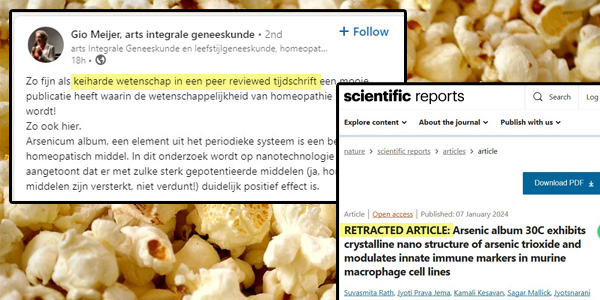
“Zo fijn als keiharde wetenschap in een peer reviewed tijdschrift een mooie publicatie heeft waarin de wetenschappelijkheid van homeopathie ‘bewezen’ wordt!” berichtte Gio Meijer gisteren juichend op LinkedIn. Meijer is voorzitter van de vakgroep homeopathie van de AVIG, dus zeg maar de huidige hoogste hotemetoot onder artsen die er ook nog homeopathie bij denken te kunnen doen.
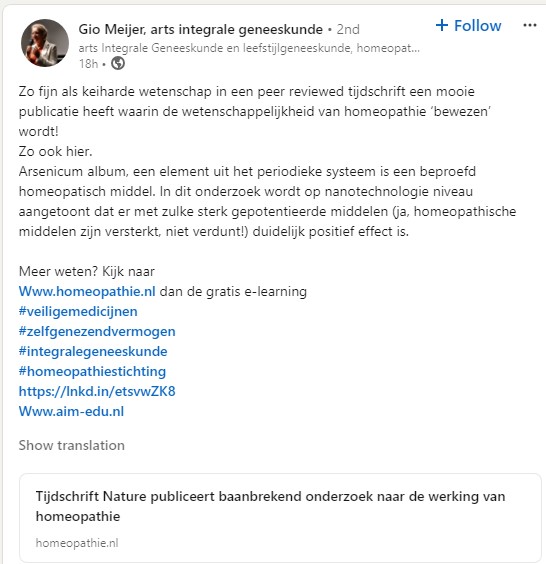
Tsjonge, keiharde wetenschap, in het gezaghebbende tijdschrift Nature nog wel! Even kijken waar dat over gaat. Meijer deelt hier een blogje op de website homeopathie.nl van de VHAN, waarvan zij ook voorzitter is en dat geschreven is door Ton Nicolai, ook al zo’n bobo in homeopathiekringen.
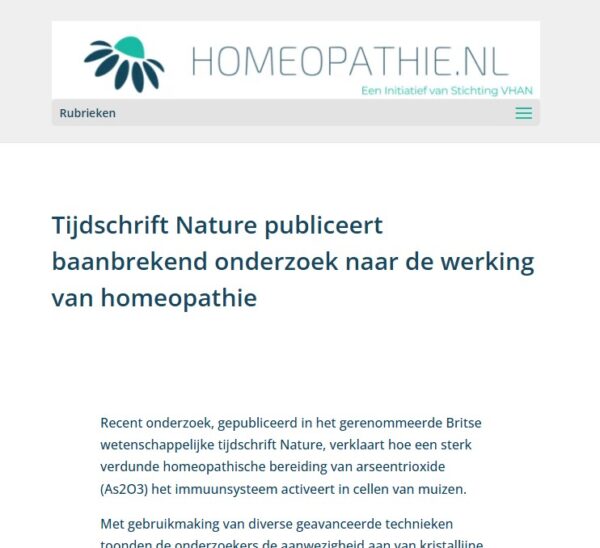
Wie onderaan doorklikt naar het ‘origineel artikel in Nature‘ komt meteen voor een paar verrassingen te staan. In de eerste plaats zie je dat het niet Nature betreft maar het veel lager aangeschreven Scientific Reports, maar er staat ook met koeienletters ‘RETRACTED ARTICLE‘!
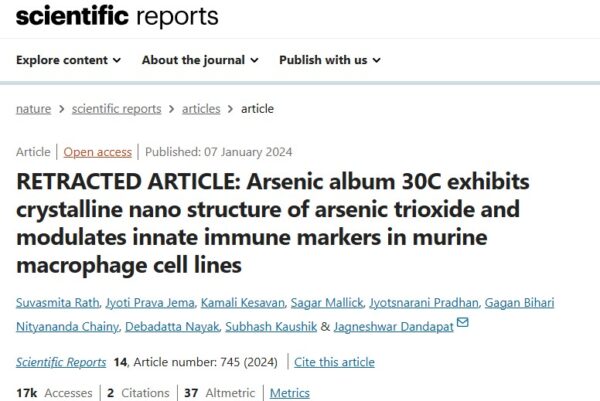
Dat Scientific Reports is wel uit de stal van Nature, maar echt niet hetzelfde als dat journal. Beetje gek ook dat Meijer met haar juichende bericht komt als dat artikel al bijna twee weken geleden ingetrokken blijkt te zijn. Van wanneer het bericht op de site van de VHAN precies is, weet ik niet (webarchive lijkt een poging gedaan te hebben het te archiveren in april), maar het is natuurlijk wel erg suf om het dan nu nog te delen.
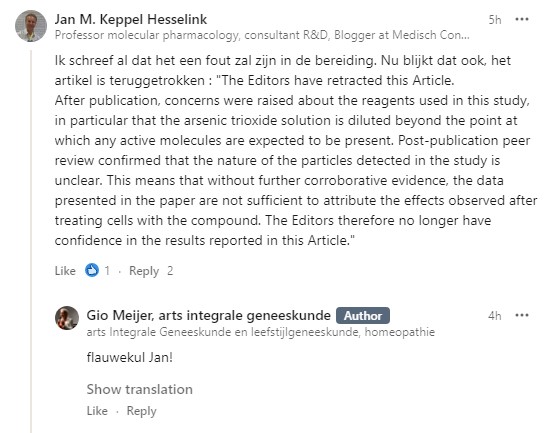
Zelfs Jan Keppel Hesselink lijkt vooralsnog er niet in te slagen dat Meijer hier een enorme flater begaat. Ze vertelt in de comments ook nog dat ze het “speciaal door een hoogleraar immunologie extra [heeft] laten checken”. Dat zal wel slaan op het commentaar van Pierre Capel dat we ook op de VHAN site vinden. “Het gepotentieerd Arsenicum preparaat is dus gewoon een perfecte immun-stimulans.” schrijft hij, terwijl hij dus niet doorheeft dat het daadwerkelijk aantreffen van materiaal in deze C30-oplossing juist betekent dat er iets is misgegaan met de homeopatische bereiding.
Erg verrassend is het ook weer niet dat homeopaten met wat geklets over nanopartikels denken hun merkwaardige hobby te kunnen onderbouwen, dat doen ze namelijk met zo’n beetje alles wat maar wetenschappelijk klinkt, zie Homeopathie als lachspiegel van de wetenschap (Skepter 32.2, 2019).
We gaan ongetwijfeld spoedig in een column van Keppel Hesselink op Medisch Contact lezen hoe het verder gaat. We houden de popcorn bij de hand!
NB Edzard Ernst had vorige week al een berichtje over de intrekking van dit artikel op zijn blog.

De redactie bevestigde dat deze terugtrekking is gebeurd naar aanleiding van een ‘Expression of Concern’ van ondergetekende in april dit jaar, al is het mogelijk dat er meer meldingen ontvangen waren (dit laatste wilde men niet bevestigen of ontkennen).
Het blijkt dus dat het insturen van dergelijke formele kritiek absoluut zinvol is, mits gefundeerd en goed verwoord, OOK als de inzender geen academische titels enzovoort heeft.
Hieronder de integrale tekst aan het adres van Springer Nature. Dit kan als voorbeeld dienen voor wie op soortgelijke artikelen stuit met zeer fundamentele tegenspraken:
Sir, Madam,
Recently, my attention was drawn towards an article published in Scientific Reports by the title of Arsenic album 30C exhibits crystalline nano structure of arsenic trioxide and modulates innate immune markers in murine macrophage cell lines, DOI: 10.1038/s41598-024-51319-w.
In this article, some remarkable claims are made with regard to a homeopathic preparation known as Arsenicum album 30C.
As the title already says, the researchers’ central claim is that they found arsenic trioxide nanoparticles in a 30C homeopathic preparation of As2O3, and that these As2O3 nanoparticles cause immune-related responses in white blood cells (macrophages) from mice.
This claim is fatally flawed in several ways, which in my opinion invalidate this research and the conclusions based on it. This article should therefore be retracted, or at the very least any references to homeopathy should be removed from it. As a consequence, it would also appear that there are serious shortcomings in the peer review process. No proper scientist in the field of biochemistry would or should have approved this article in its current form.
Claim 1: The homeopathic preparation Arsenicum album 30C as investigated contains measurable amounts of arsenic trioxide.
Flaw 1a: A homeopathic preparation 30C is in fact a 1:10⁶⁰ dilution of the base material, in this case arsenic trioxide (As2O3). If this dilution has been prepared correctly, it should not contain a single molecule of arsenic trioxide any more. At every 1:100 serial dilution step, the number of As2O3 molecules should be reduced by 99%, with the last molecule being diluted away and discarded around the 12th step (12C), or 1:10²⁴ — the limit also known as Avogadro’s number. This core principle of dilution is universally accepted by real scientists as well as homeopaths.
If the researchers used a properly prepared 30C dilution of arsenic trioxide, then by definition they should not find any As2O3 molecules at all.
If, on the other hand, the researchers did find arsenic trioxide in what they believe is a 30C dilution, then that dilution again by definition (even homeopathic definition) cannot have been 30C; most likely, the real dilution lies around 6C at best, equating to at least something in the order of 1 part per trillion (the practical detection limit for heavy metals using TEM)[1].
In other words: a 30C dilution of Arsenicum album and the measurable presence of arsenic trioxide are mutually exclusive. The researchers’ claims about the dilution they worked with cannot possibly be correct. Yet throughout the article, the researchers mention working with Ars. alb 30C — no less than 77 times.
Flaw 1b: No attempt was made to explain, let alone quantify the amount of arsenic trioxide found. If a scientist or even a homeopath finds traceable amounts of a substance in a sample that should not contain even a molecule of said substance, then the first thing they should do is notice this, and then try to assess how much of it is present (and, of course, where it originated from, if possible). None of this happened here: researchers claimed that they worked with Arsenicum album 30C, and then simply took for granted that they found As2O3 nanoparticles, without any questions, comment or surprise, and without any further analysis or discussion of what should have been a very unexpected observation.
Claim 2: the arsenic trioxide found in the dilution was organized as nanoparticles.
Flaw 2a: With very high probability, the original Ars. alb 30C solution to which macrophages were exposed did not contain As2O3 nanoparticles at all. Arsenic trioxide is moderately soluble in water, at approximately 2.1g per 100g at 25°C, and would therefore have been present in a fully dissolved state exclusively, not as nanoparticles (unless of course the As2O3 solution was fully saturated — and thus extremely toxic as well). Any chemist should be able to confirm this.
Any nanoparticles observed using transmission electron microscopy (TEM) almost certainly originated from the evaporation of water from the liquid sample in preparation for TEM analysis (which requires dry samples). Only at that point, and not sooner, did any dissolved As2O3 crystallize into the nanoparticles that were found. Again, any chemist should be able to confirm this.
This simple, well-known and very plausible mechanism for the origin of those nanoparticles is never mentioned. Once again, the researchers unquestioningly took for granted that those nanoparticles are found, and then erroneously assumed that these were already present in the observed form in the 30C dilution.
Claim 3: The As2O3 nanoparticles are responsible for modulating the immune markers in mouse macrophages.
Flaw 3a: As there very likely were no nanoparticles at all in the homeopathic solution to which macrophages were exposed (see previous point), these also cannot have been responsible for any of the effects observed.
Flaw 3b: No proper mechanism or even rationale is given for the claim that specifically nanoparticles of arsenic trioxide would be responsible for the observed immune modulation.
Yes, arsenic trioxide by itself is known for its anti-cancer properties, and also has some immune-modulating properties[2], but these applications lie firmly in the realm of conventional pharmacology, and have no bearing on homeopathy or homeopathic Arsenicum album dilutions. Very likely, those macrophages simply responded to pharmacologically significant amounts of arsenic trioxide present in the solution.
Yet the researchers here found arsenic trioxide nanoparticles in a dried-out solution of As2O3, and then simply assumed that these nanoparticles were not only present in the original dilution (which almost certainly was not the case), but were in fact responsible for the effects in macrophages that they observed, without going into possible mechanisms, and without realizing the major flaws in both their reasoning and research methodology. Maybe worst of all, they gave homeopathy and homeopathic dilutions a highly prominent but fully undeserved role in their work, for no good reason at all.
This is not how good science is done.
Notes:
1: See among other things https://link.springer.com/article/10.1557/JMR.1998.0090
2: See e.g. https://pubmed.ncbi.nlm.nih.gov/32382983/
Mooi verwoord die kritiek!
Dank, en weer mijn complimenten voor de presentatie van de dode mus, euh, pardon, Passer Domesticus Mortuus. Nog een klein detail waar mijn oog op viel:
Euh, nee, ik dacht het niet. Of, in haar eigen woorden: “Flauwekul Gio!”
Arsenicum album (letterlijk ‘witte arsenicum’) is homeopathisch potjeslatijn voor arsenicumtrioxide, en dat is geen element maar een verbinding.
Dit soort fundamentele blunders suggereren eens te meer aan dat homeopaten wetenschappelijk incompetente knoeiers zijn, die geen benul hebben waar ze over praten of zelfs maar waar ze mee bezig zijn.
Overigens had ik nog overwogen om de Expression of concern nog uit te breiden met het volgende:
“If a 30C dilution of arsenic trioxide obtained from a major homeopathic supplier (Dr. Reckeweg.co, Germany) still contains measurable amounts of arsenic trioxide, then that is a very severe problem. It indicates that the dilution process used by Dr. Reckeweg.co is badly flawed, and that products from Dr. Reckeweg.co cannot and should not be trusted.
This problem is all the more severe because at no point is it clear how much arsenic trioxide is actually present. Once again, a 30C dilution should not contain a single molecule of the base substance any more. If arsenic trioxide is still present in unknown but measurable quantities, then this could pose a very serious health hazard. Arsenic trioxide is an extremely toxic substance, the ingestion of even a few dozen milligrams of which can already be fatal, and anyone using Ars. alb 30C from Dr. Reckeweg.co as a homeopathic medicine could be at risk of arsenic poisoning. That this is not a hypothetical risk, is exemplified by the Hyland teething tablets scandal, where a flawed dilution procedure of a deadly nightshade preparation may have fatally poisoned several babies and was confirmed to have injured hundreds more.”
Een van de redenen om dit achterwege te laten is dat dit vooral kritiek is op Reckeweg, en niet zozeer op het Indiase onderzoek, en dus minder relevant.
Maar ik zou evengoed graag eens een monster van die Arsenicum album 30C van Reckeweg willen onderzoeken op de aanwezigheid van arsenicumtrioxide …
It’s interesting how some still cling to “proof” that’s been retracted. What does that say about the foundation of their beliefs?
http://www.liverpoolautoglass.au/
@Summer Smith
Juist, homeopathie is slechts geloof, even absurd als iedere andere religie.
De heer Summer Smith maakt reclame voor een bedrijf voor autoruiten in Australië. Niet echt iets waar we behoefte aan hebben. Misschien wel aan de reparatie of vervanging van autoruiten, maar een bedrijf in Australië lijkt me niet de eerste keuze.
Voor een nieuwe autoruit zou ik ook niet naar Australië gaan maar daar heeft Smith het hier toch helemaal niet over? Hij trekt het gezond verstand in twijfel van mensen die enerzijds in iets blijven geloven waar ze ‘officieel’ niet meer achter staan. Daar heeft hij m.i. volstrekt gelijk in.
@ Hans,
Misschien is m’n reactie ingegeven door m’n ervaring met spam op bepaalde fora, maar ik had het gevoel dat de korte reactie van de heer Smith in feite bedoeld was om de link die er onder stond te kunnen plaatsen.
En dat dan allemaal nog afgezien van de ideetjes van meneer Hahnemann v.w.b. zijn onzinnige proefjes.
Richard, goed bezig, een prachtige e-mail en helemaal goed dat het (vlot) heeft geleid tot een retraction van deze onwetenschappelijke rommel. Je e-mail is nu ook leesbaar via https://pubpeer.com/publications/298716A954B7BE5B36ADEE01EF66C1
Dank, ook voor het plaatsen van de link hiernaartoe.
Overigens ben ik ook soortgelijke gevallen aan het bekijken, dus onderzoeken waarbij het schudwatervolkje beweert te werken met extreme verdunningen (> 12C) van willekeurige substanties, echter ook doodleuk meldt dat die substanties daadwerkelijk worden aangetroffen bij analyse, vaak in de vorm van ‘nanodeeltjes’. De twee claims zijn per definitie in tegenspraak met elkaar, en zouden dus altijd moeten leiden tot terugtrekking van de desbetreffende artikelen, of in ieder geval van artikelen waarin effecten worden toegeschreven aan die substantie.
Het aardige is dat het verder volstrekt irrelevant is wat die geobserveerde effecten zijn of welke analysetechnieken zijn gebruikt, of zelfs maar wat het specifieke vakgebied is (in dit geval dus biochemie en/of immunologie).
Evengoed is het van groot belang om zorgvuldig te werken en de kritiek ook te verwoorden met referenties naar het onderzoek zelf. Alleen maar wijzen op “30C & moleculen gevonden => fout onderzoek” is denk ik wat te kort door de bocht, ook al is het volgens de wiskundige logica correct.
Richard, graag gedaan en erg goed dat je hier zoveel tijd en moeite insteekt. Schudverdunners zijn al erg lang bezig de wetenschap te ondermijnen door middel van pogingen hun onwetenschappelijke schrijfsels in wetenschappelijke tijdschriften gepubliceerd te krijgen. Peer-review is niet onfeilbaar. Het lukt daardoor af en toe om zulke schrijfsels gepubliceerd te krijgen. Vaak kost het dan enorm veel tijd en moeite de zaak weer teruggetrokken te krijgen. Uiteraard weten de schudverdunners dat ondertussen ook. Vaak betekent het dat heel erg goed in de materie moeten zitten om precies door te krijgen waar ze ergens de mist in zijn gegaan. Ga er vooral mee door!
Mijn eerste snelle conclusie is dat meneer Meijer niet heeft leren spellen. Dat staat wel heel erg dom voor een arts. Tja, als je hoog opgeeft over het nut van miljoensten van microhoeveelheden, moet je niet gek opkijken als een lezer van je ‘social media’ valt over zo’n kleinigheid.
En nu ga ik verder lezen.
Gio Meijer is een vrouw 😉 Maar ze geloof behalve in homeopathie in wel meer rare dingen, oa dat tafelbergen en soortgelijke geologische formaties eigenlijk restanten van reuzenbomen uit een ver verleden zijn …
Ik nam zonder meer aan dat Gio een afkorting zou zijn van Giovanno maar het moet dus van Giovanna zijn. Hoe dan ook, naast het constateren van die domme spelfouten die een arts in mijn ogen niet zou moeten maken, spitste ik ook meteen mijn oren bij het onnodig vermelden van het periodiek systeem enz. Verder lezend blijkt de mus wel heel erg dood te zijn. Ik vrees dat u erg veel popcorn nodig zult hebben voordat integrale Gio (hé, ze noemt zich niet integratief, dat andere onzinwoord) toegeeft dat homeopathie een allang verlaten en onwerkzaam theorietje is, zoals er zovele zijn. Waarom zouden artsen zulke flauwekul gaan aanhangen terwijl ze toch een gedegen opleiding hebben gevolgd? Het is bepaald geen aanbeveling!
En dan heeft ze het nog over het periodieke systeem, terwijl het toch echt periodiek systeem moet zijn.
Je zou toch zeggen dat je voor een artsenstudie scheikunde in je vakkenpakket moet hebben. Dan moet je toch ook iets geleerd hebben over de constante van Avogadro.
Avogadro? Nee, dat gaat deze dame ver boven de pet. In machten van tien denken terwijl ze niet eens foutloos kan spellen? Zou ze überhaupt het begrip logaritmen kennen?
Dat zie je steeds bij kwakzalvers. Die gebruiken terminologie die ze niet beheersen en waarmee ze meteen genadeloos door de mand vallen.
Er zijn helaas massa’s mensen die wél in hun onzin trappen. Vechten tegen de bierkaai blijft het voor ons.
Tja de kwakzalvers weten altijd wetenschappelijke termen zo te martelen dat ze deze in hun kraam kunnen gebruiken en daar hun aanhang ook niet precies weet wat er met deze termen bedoeld wordt, komen de kwakzalvers er mee weg.
Eerst had men kwantum (natuurlijk door de quackzalvers verbasterd tot quantum, want dat staat mooier). Toen kwam men nog even met het geheugen van water, waar weinig wetenschappelijks aan zat en nu zijn nanodeeltjes de trend, waarbij men de klok wel heeft horen luiden, maar werkelijk absoluut geen enkel idee heeft waar de klepel zich bevindt. Wat men zich namelijk niet realiseert is dat nanodeeltjes weliswaar zeer klein zijn, maar dat ze niet kleiner zijn dan atomen of moleculen.